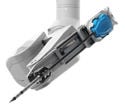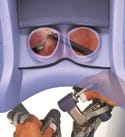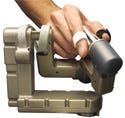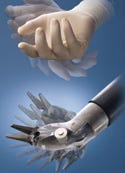In the Operating Theater, Intuitive Surgical is the Main Act
With its breakthrough robotic system that is unmatched by any other medical device, Intuitive Surgical continues to innovate while keeping quality of patient care and device design top priorities.
November 1, 2007
MANUFACTURERS OF THE YEAR
|
The da Vinci's mobile patient cart holds the robotic arms, which can move based on the surgeon's movements. |
Intuitive Surgical Inc. (Sunnyvale, CA) launched the revolution known as robotic-assisted surgery eight years ago. Armed with a product that is unrivaled in the industry, the company is marketing one of the most sophisticated devices that the operating room has ever seen—the da Vinci Surgical System.
Its exceptional management team, strong relationship with surgeons, and close attention to quality and detail have created a formula for success. The company employs what it calls a patient value equation, posing the question of how it can improve the efficacy of a procedure while reducing its invasiveness.
“They took a complex but in some ways simple idea of providing the surgeon with better visualization, more comfort, and greater accuracy, and turned it into the da Vinci system, which was an act of mere genius to conceptualize,” says Rick Wise, financial analyst at Bear, Stearns & Company, Inc. (New York). “This is a company that had enough vision to understand the complexity of executing its business plan. Intuitive has been a company mature beyond its years.”
From the intricacies involved in device manufacturing to the complexity of the surgery performed by the robot, Intuitive Surgical is a true innovator. Competitors are years away from catching up, and the company has firmly planted itself as a leader in its field.
The Start of the Revolution
The company's roots in medical robotics date back to the 1980s, when the U.S. Department of Defense funded research to create a device for remote battlefield surgery. SRI International Inc. (Menlo Park, CA), a nonprofit research institute, developed a system that sparked interest from people who saw its direct applicability in the commercial surgical market. Intuitive Surgical was founded several years later, in 1995, to work on this concept.
It took the company only four years to launch its flagship product, which became the first robotic surgical system cleared by FDA for laparoscopic surgery. The da Vinci isn't a robot that operates on its own, but rather it is the interposing of a computer-based system between the hands and eyes of a surgeon and a patient. “It can't be programmed, it can't make any decisions on its own, and it's not autonomous,” says Steve Annen, director of product development at Intuitive Surgical. “It's 100% driven by the movements of the surgeon.”
|
The da Vinci system's camera provides a three-dimensional perspective of the surgical field. |
The da Vinci performs surgery via 1–2-cm incisions and aims to provide the same benefit that a patient would receive from open surgery without the invasiveness and long recovery time. It was first used for prostatectomies and has nearly become the standard of care for the procedure. Now with the device's use moving into other applications in urology and new territories in gynecology, mitral valve repair, revascularization, and gastric bypass surgery, Intuitive Surgical has a strong advantage over any future competition.
In a Category by Itself
Other companies manufacture robotic products, but none of them has a device on the market with the same capabilities of the da Vinci in combination with its surgical indications. Intuitive Surgical's acquisition of Computer Motion in 2003 also ensured that the company wouldn't face rivals for years.
“It's in a really good position because it has a monopoly depending on how you define the market,” says Michael Matson, senior analyst in medical device equity research at Wachovia Capital Markets LLC (New York). “It had to develop the market for this type of product, because it doesn't have any true competitors that make the same type of product.”
Intuitive Surgical competes with other surgical methods like open surgery and minimally invasive techniques such as laparoscopy. Because minimally invasive surgery (MIS) is performed through small ports instead of one large incision, its benefits include shorter recovery, fewer complications, and reduced hospitalization costs. MIS has become the standard of care in a number of areas but hasn't been widely adopted in more complex or delicate procedures like prostatectomies, mitral valve repair, or certain hysterectomies, according to Annen. The da Vinci robot enables a minimally invasive method to be applied to these complex procedures.
“The goal of Intuitive Surgical is to extend the benefits of MIS to the broadest possible base of patients,” says Annen. “The strategy is to allow the clinically based evidence to show that the da Vinci approach is a better approach.”
The Push to Adoption
|
A digital handshake recognizes each disposable tool as well as its function and how many times it has been used. |
Although the company knew that using the da Vinci to perform surgery dramatically affects both the surgeon and the patient, convincing doctors and hospitals that it was superior to other surgical options wasn't a fast and simple task. With a price tag of more than $1 million per robot, Intuitive Surgical needed strong evidence that would drive home the benefits from both a cost and clinical outcome standpoint.
When it first approached hospitals, the company positioned itself as an extension of their investment in MIS technology. During the past 20 years or so, medical centers have put a lot of money into MIS with the intent to draw incremental patients, according to Alexis Morgan, marketing communications manager at Intuitive Surgical. “Patients are attracted by the prospect of having a less-invasive procedure to treat their disease. Conventional laparoscopy can only take a hospital so far, because you can't use it for complex surgery.”
Much of the work began with surgeons who were, and still are, the pioneers in demonstrating the robot's potential. When a surgeon documented a method for using the da Vinci and published the results, the company took the information to demonstrate better patient outcomes. As the evidence began to grow, so did the robot's acceptance. Intuitive Surgical continues to use this formula to achieve its goal of applying the technology across as many procedures as possible, but it isn't hasty in expanding the da Vinci's applications.
“We're always looking at new procedures,” says Annen. “[But], we feel there are a number of procedures within urology, gynecology, and cardiology where the da Vinci can still bring value, and it's just a matter of working with surgeons in developing and documenting the clinical technique.”
Prostatectomy remains the da Vinci's marquee procedure. Out of the 90,000 prostatectomies performed in the United States last year, the da Vinci performed about 35% of them. While hysterectomy procedures were only about 2% penetrated last year, Matson estimates that the company will exit this year with more than 6% penetrated.The field of gynecology is the da Vinci's fastest-growing specialty in terms of raw percentage, according to Annen. In this sector, the company started in oncology and moved into surgery for uterine fibroids. The company is also moving into a subspecialty called urogynecology to treat vaginal prolapse.
|
A viewer provides the surgeon with a three-dimensional perspective of the surgical area. |
Matson anticipates that the next fruitful area for the da Vinci will be in gastric bypass procedures. “It's a sizable market—probably more than 150,000–200,000 procedures a year.” This could be a big driver by 2009.
Beyond the five main areas in which the da Vinci is being used, Matson expects the company to continue to make enhancements to the robot that will enable it to move into new territory. He cites natural-orifice transluminal endoscopic surgery as one possible emerging area in which the da Vinci could be applied. This method removes an organ, for example, through one of the body's orifices.
The Groundbreaking System
“We have a very strong mission statement that says we're committed to delivering significantly superior measurable patient value by focusing on surgical outcomes,” says Annen. “We do this by providing state-of-the-art technology to our surgeons with superior visualization, instrument dexterity, and precision. We're very focused on continuing to innovate in what we consider to be a field in its infancy.”
The da Vinci system has three major components that work in concert to provide an intuitive interface for surgeons. The mobile patient cart holds the robotic arms and moves them based on the surgeon's movements. Seated at a console, the surgeon looks through a viewer to get a three-dimensional (3-D) perspective of the surgical field. He uses two joysticks to move the arms and open and close the fingers, while his movements are replicated by the EndoWrist instruments in real time. The 3-D visualization is superior to laparoscopic procedures, which are only able to provide a two-dimensional view.
Because the instruments are fully articulated, surgeons can apply the same techniques used during open surgery—such as suturing—through smaller incision ports. In laparoscopy, surgeons use a different method of tying knots and suturing because of the limitations of the instruments.
There are about 40 types of EndoWrist instruments, which are available in 5- and 8-mm sizes and can be used 10–15 times. Specifically designed for each procedure, the disposable tools have a digital handshake that recognizes the type of tool, its function, and how many times it has been used. The interface prevents the use of dull and worn instruments as well as knockoffs.
|
The da Vinci system's robotic arm moves based on the surgeon's movements. |
Disposable tools also provide the company with a means for bringing in additional revenue from a single da Vinci system. Intuitive Surgical follows the razor blade business model. Although the robot costs between $1 million and $1.7 million, revenue is generated from the instruments and accessories, which cost between $1500 and $2000 per procedure. It also offers a service component that sells for between $100,000 and 150,000 per year, per system. This year the average sales price of the system, which is available in five configurations, is around $1.3 million.
In order to stay on top of the market, Intuitive Surgical continues to collaborate with companies that are using state-of-the-art technology. In some cases, it partners with manufacturers of tools that are used in conventional laparoscopy to create instruments that are compatible with the da Vinci system.
“If you look at the instruments we've launched, you'll see that several are a marriage between existing instrument technology and adapting it to a wristed architecture,” says Annen. “If you were to compare our instrument line with what's used laparoscopically, there is a one-to-one correspondence.”
The Evolutionary Approach
Intuitive Surgical continues to make strong enhancements to the da Vinci system, despite a lack of competition. In January 2006, it launched the da Vinci S, an improved version of the original device platform. Earlier this year, the company introduced a high-definition vision system to the da Vinci S for better visualization, tissue detail, and identification of anatomical structures.
The company is also focused on building its already extensive patent portfolio. It currently has exclusive rights to more than 450 U.S. and foreign patents.
By the end of June 2007, the company had installed 656 da Vinci systems worldwide, 77% of which are located in North America. Seventy-one hospitals own more than one da Vinci, and six have as many as four systems.
|
The fully articulated instruments enable surgeons to apply the same techniques that they would during open surgery. |
The company has between 650 and 675 employees and is growing at a very fast pace. Each system in every hospital has a strong clinical and field engineering support network. Annen says that employees provide support to hospitals on a daily basis.
One key to Intuitive Surgical's success is its attentive approach. “We have a very focused management team and that permeates down to all of the people in the company,” says Annen. “The challenges we face are what very ultra-fast-growing companies face—bringing on very talented people and keeping focus on the company's goals.”
Neil Ball, president of Directed Light Inc. (San Jose) has worked with Intuitive Surgical and continues to be impressed by the company's structure and engineering expertise. “They've assembled quite an incredible team, and the way they run that company is like a Swiss machine. It's amazing to watch these guys build these incredible devices.” He says some of the most outstanding aspects of the company are its thoroughness and strong commitment to product quality.
About 2000 parts make up each da Vinci robot. John Major, director of manufacturing at Intuitive Surgical, equates its complexity to that of building a car with tolerances in the tens of thousandths of an inch. When manufacturing the system, the company focuses most of its efforts on standardizing the assembly process and eliminating wasteful activities. Each device is built in subassemblies, which are individually tested before being put together. The system and its instruments are clinically tested in a dry lab setting and then shipped to hospitals.
The company also creates videos to show its technicians specific processes at each workstation. Employees go through weeks of extensive training before they become certified to ensure that they can meet high productivity and quality standards. The thorough orientation program lasts about three weeks. When employees begin at Intuitive Surgical, they're assigned to a dedicated trainer for their first 40 hours, which are mostly spent becoming familiar with the company. During their second week, they work on the production lines with the assistance of a trainer. By the third week, employees are certified. This qualification process ensures that employees are able to maintain the level of efficiency that is required to keep up with Intuitive Surgical's rapid growth.
Just as it values the quality of its employees, the company also places its customers in high regard. “We look at our customers as the surgeons, the OR staff, and the hospital administration. Helping them to become successful [is important],” says Annen. “Our goal is to be excellent at our operational activities [in order] to deliver highly reliable products and accessories.”
Conclusion
While the sky might be the limit for Intuitive Surgical, the company is moving its technology forward one procedure at a time. The meticulous and incremental approach to developing breakthrough technology is evidence of its dedication to innovation and high quality of care.
“These guys are improving people's lives,” says Ball. “I think they'll continue to evolve their platform and drive to make it the standard procedure for some of the routine procedures that we have in the United States right now, if not all over the world.”
Maria Fontanazza is senior associate editor of MD&DI.
Copyright ©2007 Medical Device & Diagnostic Industry
About the Author(s)
You May Also Like







.png?width=300&auto=webp&quality=80&disable=upscale)
